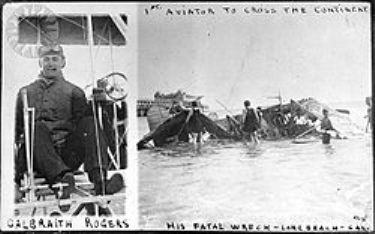 |
Cal Rodgers |
Fatal Crash
Calbraith
Perry Rodgers (January 12, 1879 - April 3, 1912) was an American
aviation pioneer. He made the first transcontinental airplane
flight across the U.S. from September 17, 1911, to November 5, 1911,
with dozens of stops, both intentional and accidental. The feat
made him a national celebrity, but he was killed in a crash a few
months later at an exhibition in California.
Rodgers was born on
January 12, 1879, in Pittsburgh, Pennsylvania, and later lived in Havre
de Grace, Maryland. He contracted scarlet fever which left him
deaf in one ear and hearing impaired in the other ear.
He was related to Commodores Oliver Hazard Perry and Matthew Calbraith Perry and had a cousin, John Rodgers, in the Navy's Aerial Corps, learning to fly the Navy's newly purchasedd Wright airplane.
In March 1911, he visited John at the Wright Company
factory and flying school in Dayton, Ohio and became interested in
aviation. He received 90 minutes of flying lessons from Orville
Wright, and on August 7, 1911, he took his official flying examination
at Huffman Prairie and became the 49th aviator licensed to fly by the Federation Aeronautique International. He was one of the first civilians to purchase a Wright flyer.
Cross Country Flight
Publisher William Randolph Hearst offered the Hearst prize,
US $50,000 to the first aviator to fly coast to coast, in either
direction, in less than 30 days from start to finish. Rodgers had
J. Ogden Armour,
of Armour and Company, sponsor the flight, and in return he named the
plane, a Wright Model EX designed for exhibition flights, after
Armour's grape soft drink Vin Fiz.
Rodgers
left from Sheepshead Bay, New York, on September 17, 1911, at
4:30 p.m. He reached Chicago on October 9, 1911. It was
decided to avoid the ROcky MOuntains, he would take a southerly route,
flying south through the midwest until reaching Texas. He turned
west after reaching San Antonio. On November 5, 1911, he landed
at Tournament Park
in Pasadena, California, at 4:04 p.m. in front of 20,000 people.
He had missed the prize deadline by 19 days. On December
10, 1911, he landed in Long Beach, California, and taxied his p lane
into the Pacific Ocean. He had carried the first transcontinental
U.S. Mail pouch. The trip required 70 stops, and he paid the
Wright brothers' technician, Charlie Taylor,
$70 a week to be his mechanic. Taylor followed the flight by
train and performed maintenance for the next day's flight. The
next transcontinental flight was made by Robert G. Fowler.
Death
On
April 3, 1912, while making an exhibition flight over Long Beach,
California, he flew into a flock of birds, causing the plane to crash
into the ocean. His neck was broken and his thorax damaged by the
engine of the airplane. He died a few moments later, a few
hundred feet from where the Vin Fiz ended its transcontinental flight. The aircraft in this last flight was the spare Model B
he had carried in the special train during the transcontinental flight,
rather than the "Vin Fiz". The "Vin Fiz" itself was later given
to the Smithsonian Institution by Calbraith's widow, Mabel Rodgers.
According
to contemporary records, his was the 127th airplane fatality since
aviation began and the 22nd American aviator to die in an accident.
He was also the first pilot who ratally crashed as a result of a
bird strike.
Rodgers was interred in Allegheny Cemetery.

 Calbraith Perry Rodgers
Famous & Infamous
Calbraith Perry Rodgers
Famous & Infamous
Copyright © 2025, TXGenWeb..
If you find any of Grayson County TXGenWeb
links inoperable,
please
send me a message.


